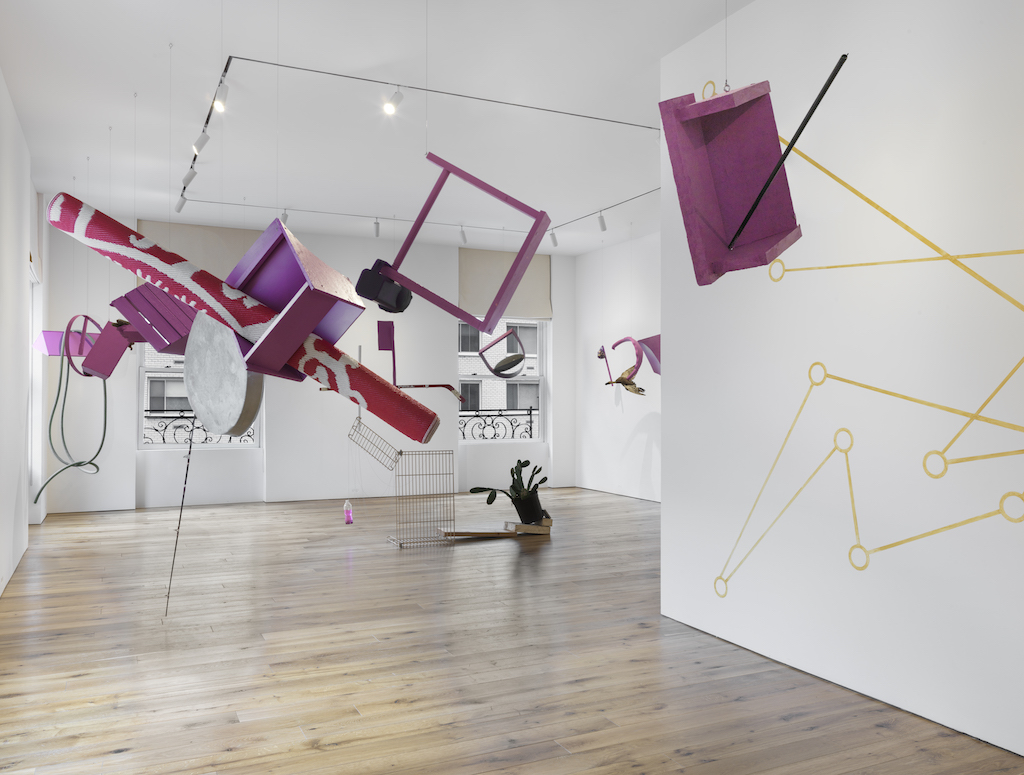[ad_1]

Installation view of “Autocontusión” at kurimanzutto New York project space.
©EPW STUDIO/MARIS HUTCHINSON, 2018
When Mexico City’s Kurimanzutto gallery was established in 1999, it was an itinerant entity with no fixed home. The gallery’s founders—artist Gabriel Orozco and gallerists José Kuri and Mónica Manzutto—staged some of Kurimanzutto’s first exhibitions in unconventional locations, like marketplaces and private apartments. But since then, they’ve settled down and opened a permanent space in Mexico City, and last week, amid the craziness surrounding the Frieze New York art fair, the gallery opened its first outpost in the United States, on Manhattan’s Upper East Side. Bree Zucker, a director of the New York gallery, told ARTnews that Kurimanzutto aims to stage exhibitions there that have “a site-specific edge,” and that approach is exemplified in the first show at the space.
Currently on view at Kurimanzutto is a solo exhibition by the Mexico City–based artist Abraham Cruzvillegas, who has created a new iteration of his ongoing project “Autocontusión.” Floating sculptures, which incorporate both perishable and manmade materials—including a pair of shoes, a deflated basketball, a wheel, and a taxidermy duck—sway gently throughout the gallery space, and viewers must enact a sort of dance to make their way around the works. Prickly pear cacti, which are native to New York, are on view throughout the gallery. Also featured are works that meditate on Manhattan as a place, including a mural of sites in New York that have been especially meaningful to Cruzvillegas since his first visit to the city in the 1990s.
“I think Manhattan is [a construction site], all of these different uses of materials that are still active, alive,” he said. “Some particular cities in the world are permanent construction sites, and permanent destruction sites as well, in terms of politics, in terms of economy, in terms of ecology, in terms of nature.”
Part of the goal of “Autocontusión” is to reflect on the life cycle of cities and objects, according to the artist. For his last New York solo show, at Tilton Gallery in 2007, the he gathered materials from spots around the Upper East Side, including a hotel and a construction site. Doors and bells from the hotel were among his most notable finds. His new show likewise includes substances native to New York—in this case, locally produced honey, as well as gold and dust. “If you touch [the mural at Kurimanzutto], it’s very sticky—it’s super easy to destroy,” he said with a smile. (Viewers aren’t permitted to touch the work, Cruzvillegas noted.)
The day after Kurimanzutto opened in New York, Cruzvillegas could be found at the Frieze New York art fair, where he gave a talk with author Yuri Herrera and artist Carlos Amorales, who also shows with the gallery. Their discussion was lively and candid, punctuated by lighthearted interludes and hearty laughs. Topics ranged from the transformation of language and identity to the importance of finding a moment of silence within one’s artwork.
At one point, Herrera compared the ways in which language is constantly changing and evolving to a table that his father made from a window for his family home.
“Is your father’s name Marcel Duchamp?” Cruzvillegas quipped.
Amid all the levity, there were more serious moments. When talking about the consumption of art on an individual level, Herrera said, “I think silence is what makes the piece ergonomical and [allows it to] adapt to every participant in the artistic process.”
At the conversation’s end, Cruzvillegas read Spanish lyrics he had written in honor of the 50-year anniversary of the 1968 Tlatelolco massacre in Mexico City, a violent event spurred by the government’s desire to quell student protestors. It was a poignant conclusion for an event that centered the concerns and practices of three Mexican artists.
“I like the idea of not choosing things myself,” Cruzvillegas said at the talk, proposing that his openness to diverse materials and the stories that they tell separates himself and his practice from “the politics of exclusion.”
Correction 5/9/18, 12:55 p.m.: A previous version of this article misstated details about a solo show by Cruzvillegas at Tilton Gallery. The show took place in 2007 and was his last solo show in New York. The post has been updated to reflect this.
[ad_2]
Source link

